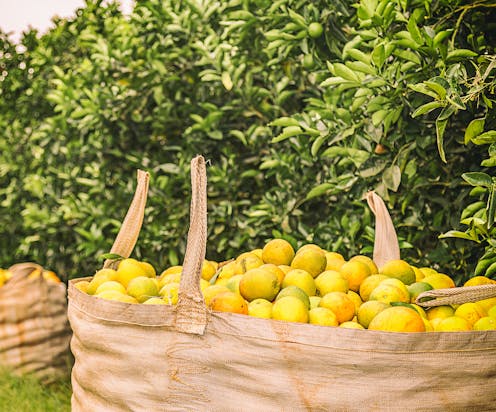The global orange juice crisis is caused by disease and bad weather – here’s how to keep it on the breakfast table
- Written by Jas Kalra, Associate Professor of Operations & Project Management, Manchester Metropolitan University

Just as the world is coming out of the tea crisis[1], another breakfast staple, orange juice, is in the spotlight. Supply constraints have led to prices shooting up by more than 20%[2] in a year.
The primary cause of this orange juice shortage is the significant hit to the orange harvest in Brazil, which accounts for nearly 70%[3] of the global supply of orange juice. This year’s harvest is expected to be down by 24% compared with last year – and this is the third harvest in a row that has been difficult.
Orange trees in Brazil, as well as in the US, have been affected by citrus greening disease[4]. This incurable disease is caused by sap-sucking insects that turn the fruit bitter before killing the tree.
Trees in Florida have been hit by a series of hurricanes as well as the greening disease – with both being attributed to climate change[5]. In terms of disease, trees are thought to be most vulnerable in regions where temperatures[6] stay around 25°C for most of the year.
Short-term ‘solutions’ present major challenges
Producers have considered mixing the new crop with frozen juice, which has a lifespan of about two years. And the International Fruit and Vegetable Juice Association[7] has been lobbying for UN food regulations to be relaxed to allow the addition of other citrus fruits, such as mandarins, to orange juice.
But these “solutions” would present major challenges for the industry in the longer term. Mixing juices requires additional processing, and the logistics and transportation of mandarins and other fruit to processing facilities would add costs[8], ultimately increasing the price of the juice.
At the same time, consumers might expect lower prices for blended juices. So this mismatch in the expected and actual price could stifle demand – in turn, restricting investment in new orange trees.
Labour costs in places such as Florida are already high, and the lack of further investment would make manual work unaffordable. Taken together, these factors could even prompt the market failure of one of the world’s staple drinks.
How to keep orange juice on the table
Addressing this problem requires some long-term strategic thinking. The supply chain[9] for orange juice includes sourcing and harvesting, cleaning and sorting, juicing, pasteurisation, packaging and sometimes additional processing.
Multiple businesses are involved[10]: growers, food handlers, fruit processors, blending houses, juice packers and soft drink producers. All operate differently. For example, in Florida, orange growers are diversifying into agribusiness companies, while in Brazil, large processors still source part of their harvest from their own land.
In the short-to-medium term, retailers and wholesalers need to look within their networks. This could mean identifying untapped suppliers to develop alternative sources – Europe has begun importing some of Egypt’s orange produce, for example.
And current supplier contracts should be amended to fix prices for the duration of the deal. Anticipating shortages, companies such as Coldpress Juices[11] maintained a safety stock[12] in 2023 and secured contracts with suppliers until December 2024. Arrangements like these create a level of certainty for everyone in the supply chain.
In the long term, retailers and wholesalers need to develop novel approaches to improve their supply chain’s resilience to climate threats.
First, investment in agricultural research to develop more resilient varieties of orange would help mitigate the impact. Research and development in infrastructure – including water-saving technologies, better soil management practices, and improved processing methods – would also help guard against disruptions.
Second, digital technologies such as drones for monitoring crops and harvest, transparent data-sharing across the network, and improved forecasting would strengthen governance, control and coordination in the supply chain. However, the need for investment in research and technology has been a barrier to supply chain innovation.
Recent evidence suggests[14] that downstream businesses (wholesalers and retailers) in the agri-food supply chain invest more in digital and other technology than smaller upstream businesses such as farmers, small- and medium-sized enterprises, co-operatives and smallholders. But supply chain innovation requires progress throughout the network. This means that wholesalers and retailers in particular would need to absorb the initial cost of any investment.
Finally, supply chain transparency and visibility could be enhanced by the buying firms forming consortia and buying clubs, where they share information to help gauge customer demand. This approach helps prevent the “bullwhip effect”[15], reducing accidental over-production and wastage.
This strategy of competitors cooperating with each other – known as “coopetition” – can also help them to jointly absorb the costs of logistics and innovation.
By implementing long-term strategies like these, retailers and wholesalers can create a more resilient and efficient food supply chain. With climate change bringing increasing challenges for harvests, this will be vital if we are to ensure a stable supply and keep orange juice on the breakfast table.
References
- ^ tea crisis (theconversation.com)
- ^ more than 20% (www.birminghammail.co.uk)
- ^ 70% (www.theguardian.com)
- ^ citrus greening disease (www.aphis.usda.gov)
- ^ climate change (plantbasednews.org)
- ^ temperatures (www.labroots.com)
- ^ International Fruit and Vegetable Juice Association (ifu-fruitjuice.com)
- ^ add costs (www.theguardian.com)
- ^ supply chain (www.everythingsupplychain.com)
- ^ are involved (orangebook.tetrapak.com)
- ^ Coldpress Juices (coldpress.co.uk)
- ^ a safety stock (www.thegrocer.co.uk)
- ^ Zuma Press/Alamy Stock Photo (www.alamy.com)
- ^ suggests (www.emerald.com)
- ^ “bullwhip effect” (www.investopedia.com)







